Abstract
There is both laboratory and epidemiologic evidence that PCBs are toxic to several phases of reproduction. Workplace exposure is an important but small part of the exposure to these compounds, since most of the population has detectable levels in blood or fat. Studies in the general population on PCBs and reproduction have not been done. Some studies in workers are under way, and in epidemic PCB poisonings, small babies with a distinct clinical syndrome are seen. We review some of the laboratory and epidemiologic data and the methods available for study of reproduction in humans; study of any highly exposed group should be done and studies of spontaneous abortion, birth weight and certain congenital anomalies should look for an effect of PCBs.
Full text
PDF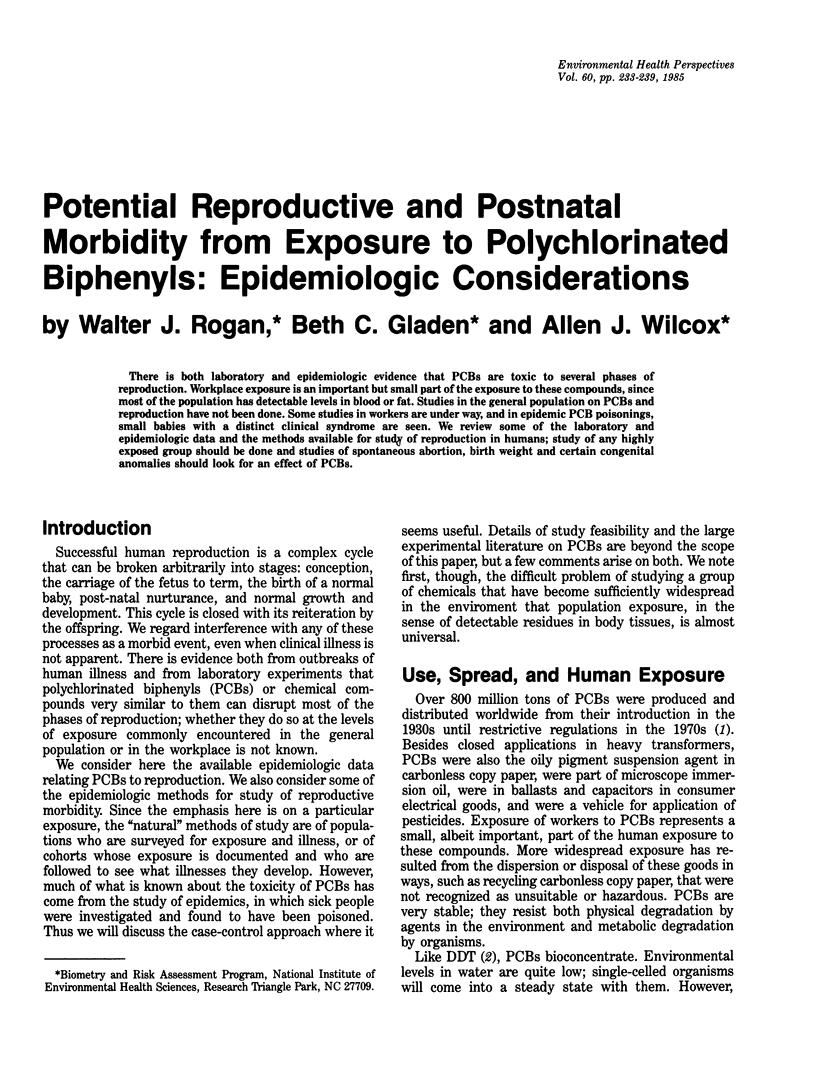
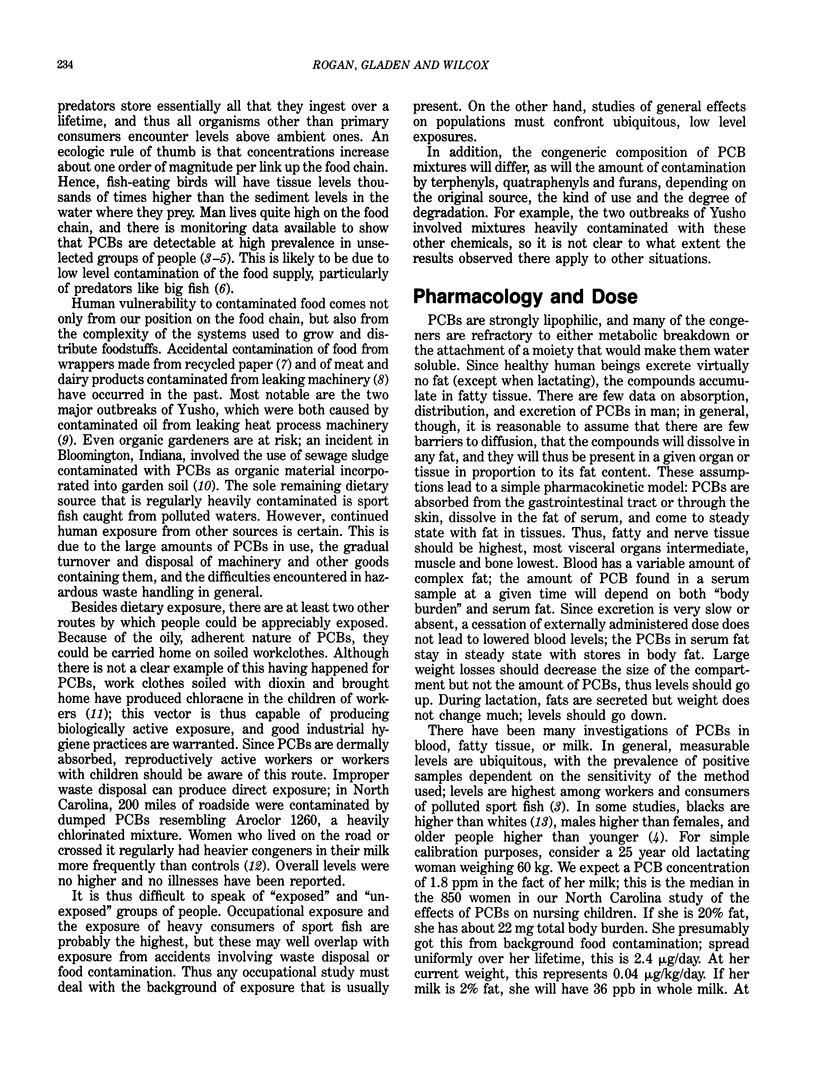
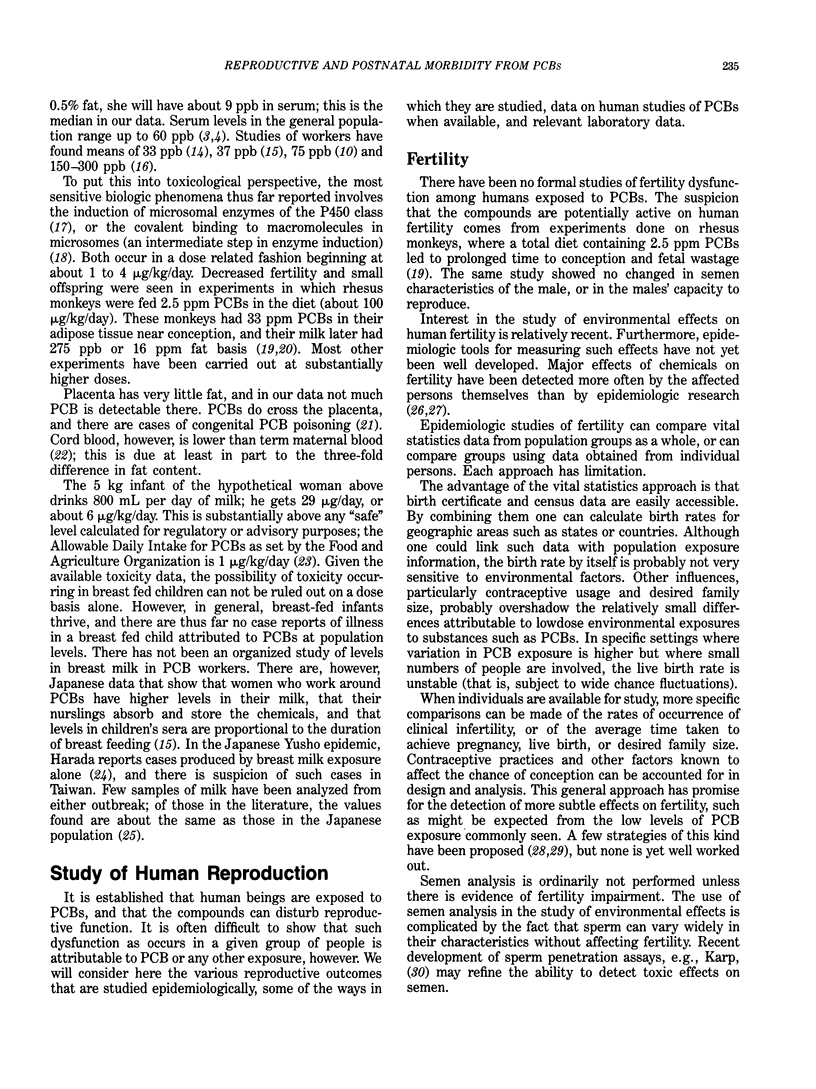
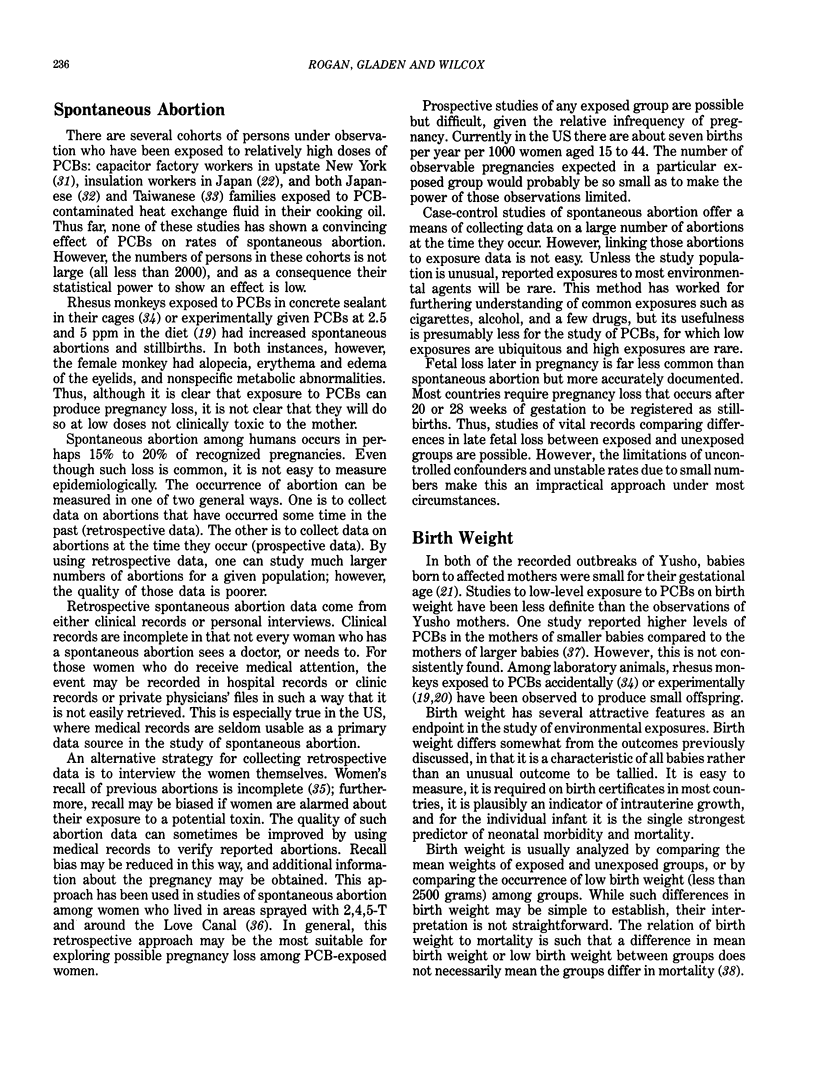
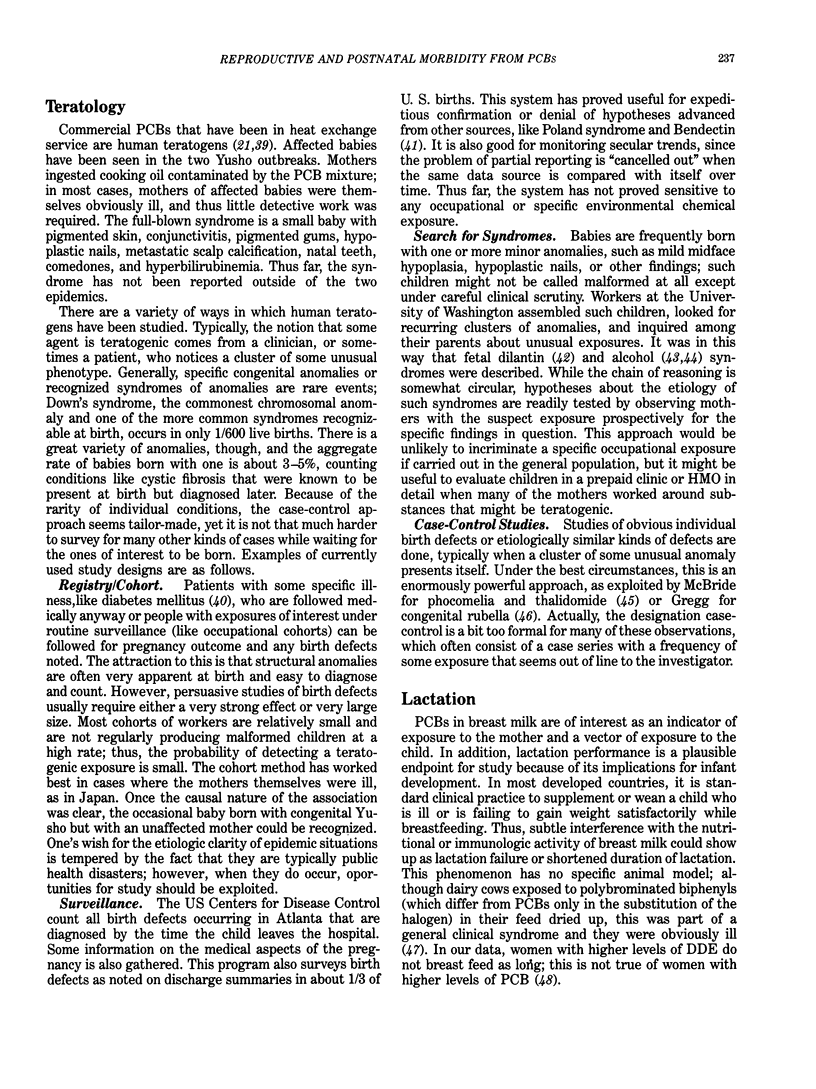
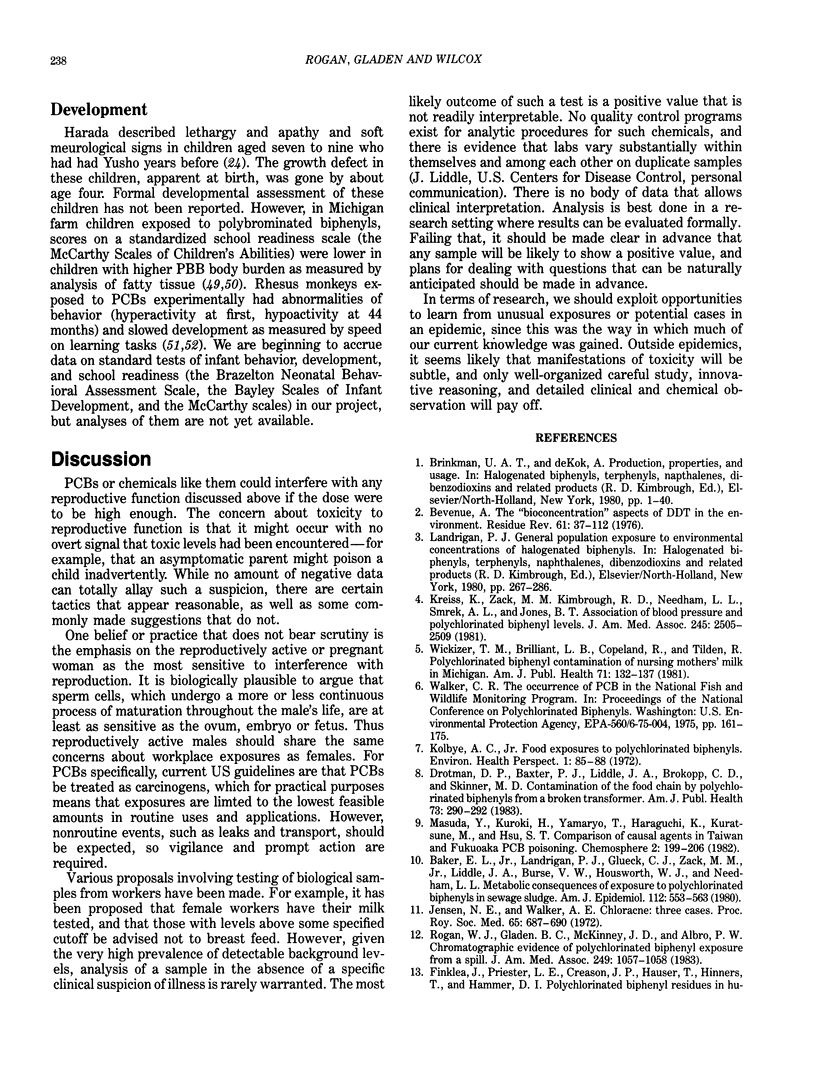
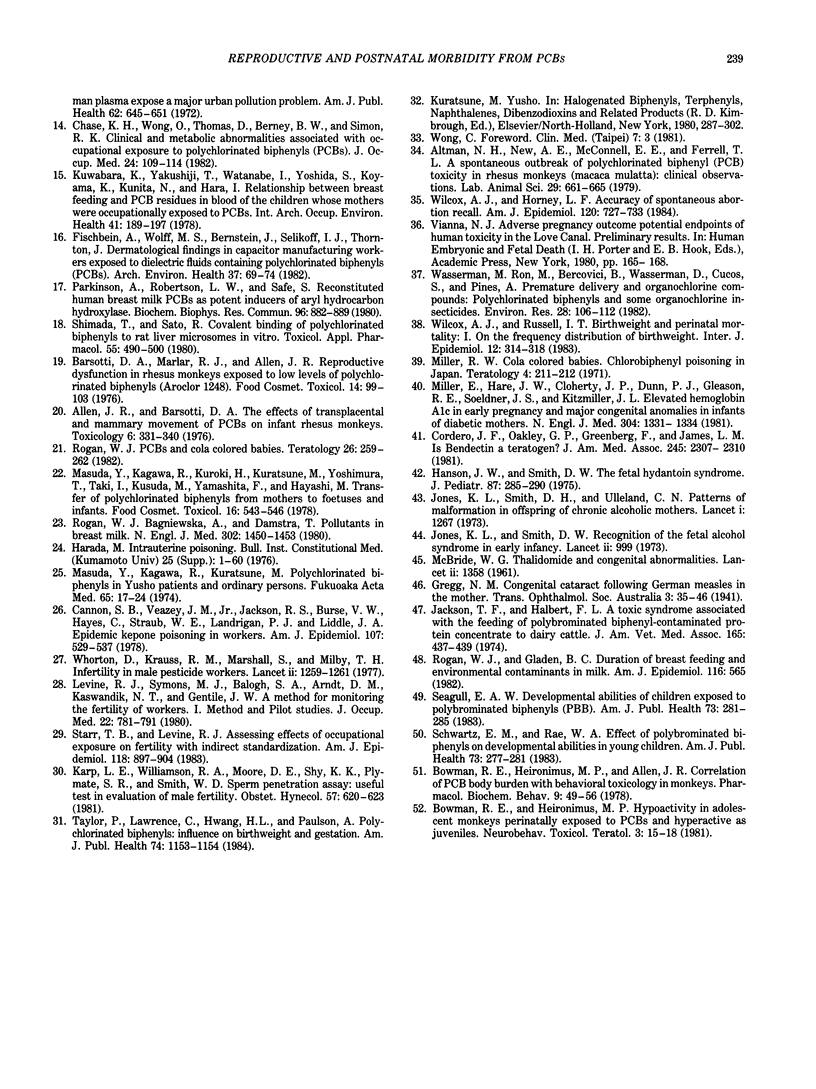
Selected References
These references are in PubMed. This may not be the complete list of references from this article.
- Allen J. R., Barsotti D. A. The effects of transplacental and mammary movement of PCBs on infant rhesus monkeys. Toxicology. 1976 Nov-Dec;6(3):331–340. doi: 10.1016/0300-483x(76)90037-8. [DOI] [PubMed] [Google Scholar]
- Altman N. H., New A. E., McConnell E. E., Ferrell T. L. A spontaneous outbreak of polychlorinated biphenyl (PCB) toxicity in rhesus monkeys (Macaca mulatta): clinical observations. Lab Anim Sci. 1979 Oct;29(5):661–665. [PubMed] [Google Scholar]
- Baker E. L., Jr, Landrigan P. J., Glueck C. J., Zack M. M., Jr, Liddle J. A., Burse V. W., Housworth W. J., Needham L. L. Metabolic consequences of exposure to polychlorinated biphenyls (PCB) in sewage sludge. Am J Epidemiol. 1980 Oct;112(4):553–563. doi: 10.1093/oxfordjournals.aje.a113024. [DOI] [PubMed] [Google Scholar]
- Barsotti D. A., Marlar R. J., Allen J. R. Reproductive dysfunction in rhesus monkeys exposed to low levels of polychlorinated biphenyls (Aoroclor 1248). Food Cosmet Toxicol. 1976 Apr;14(2):99–103. doi: 10.1016/s0015-6264(76)80251-9. [DOI] [PubMed] [Google Scholar]
- Bevenue A. The "bioconcentration" aspects of DDT in the environment. Residue Rev. 1976;61:37–112. doi: 10.1007/978-1-4613-9401-3_3. [DOI] [PubMed] [Google Scholar]
- Bowman R. E., Heironimus M. P., Allen J. R. Correlation of PCB body burden with behavioral toxicology in monkeys. Pharmacol Biochem Behav. 1978 Jul;9(1):49–56. doi: 10.1016/0091-3057(78)90012-6. [DOI] [PubMed] [Google Scholar]
- Cannon S. B., Veazey J. M., Jr, Jackson R. S., Burse V. W., Hayes C., Straub W. E., Landrigan P. J., Liddle J. A. Epidemic kepone poisoning in chemical workers. Am J Epidemiol. 1978 Jun;107(6):529–537. doi: 10.1093/oxfordjournals.aje.a112572. [DOI] [PubMed] [Google Scholar]
- Chase K. H., Wong O., Thomas D., Berney B. W., Simon R. K. Clinical and metabolic abnormalities associated with occupational exposure to polychlorinated biphenyls (PCBs). J Occup Med. 1982 Feb;24(2):109–114. [PubMed] [Google Scholar]
- Cordero J. F., Oakley G. P., Greenberg F., James L. M. Is Bendectin a teratogen? JAMA. 1981 Jun 12;245(22):2307–2310. [PubMed] [Google Scholar]
- Drotman D. P., Baxter P. J., Liddle J. A., Brokopp C. D., Skinner M. D. Contamination of the food chain by polychlorinated biphenyls from a broken transformer. Am J Public Health. 1983 Mar;73(3):290–292. doi: 10.2105/ajph.73.3.290. [DOI] [PMC free article] [PubMed] [Google Scholar]
- Fischbein A., Thornton J., Wolff M. S., Bernstein J., Selifoff I. J. Dermatological findings in capacitor manufacturing workers exposed to dielectric fluids containing polychlorinated biphenyls (PCBs). Arch Environ Health. 1982 Mar-Apr;37(2):69–74. doi: 10.1080/00039896.1982.10667538. [DOI] [PubMed] [Google Scholar]
- Hanson J. W., Smith D. W. The fetal hydantoin syndrome. J Pediatr. 1975 Aug;87(2):285–290. doi: 10.1016/s0022-3476(75)80604-4. [DOI] [PubMed] [Google Scholar]
- Jackson T. F., Halbert F. L. A toxic syndrome associated with the feeding of polybrominated biphenyl-contaminated protein concentrate to dairy cattle. J Am Vet Med Assoc. 1974 Sep 1;165(5):437–439. [PubMed] [Google Scholar]
- Jensen N. E. Chloracne: three cases. Proc R Soc Med. 1972 Aug;65(8):687–688. [PMC free article] [PubMed] [Google Scholar]
- Jones K. L., Smith D. W. Recognition of the fetal alcohol syndrome in early infancy. Lancet. 1973 Nov 3;302(7836):999–1001. doi: 10.1016/s0140-6736(73)91092-1. [DOI] [PubMed] [Google Scholar]
- Jones K. L., Smith D. W., Ulleland C. N., Streissguth P. Pattern of malformation in offspring of chronic alcoholic mothers. Lancet. 1973 Jun 9;1(7815):1267–1271. doi: 10.1016/s0140-6736(73)91291-9. [DOI] [PubMed] [Google Scholar]
- Karp L. E., Williamson R. A., Moore D. E., Shy K. K., Plymate S. R., Smith W. D. Sperm penetration assay: useful test in evaluation of male fertility. Obstet Gynecol. 1981 May;57(5):620–623. [PubMed] [Google Scholar]
- Kolbye A. C. Food exposures to polychlorinated biphenyls. Environ Health Perspect. 1972 Apr;1:85–88. doi: 10.1289/ehp.720185. [DOI] [PMC free article] [PubMed] [Google Scholar]
- Kreiss K., Zack M. M., Kimbrough R. D., Needham L. L., Smrek A. L., Jones B. T. Association of blood pressure and polychlorinated biphenyl levels. JAMA. 1981 Jun 26;245(24):2505–2509. [PubMed] [Google Scholar]
- Kuwabara K., Yakushiji T., Watanabe I., Yoshida S., Koyama K., Kunita N., Hara I. Relationship between breast feeding and PCB residues in blood of the children whose mothers were occupationally exposed to PCBs. Int Arch Occup Environ Health. 1978 May 12;41(3):189–197. doi: 10.1007/BF00572891. [DOI] [PubMed] [Google Scholar]
- Levine R. J., Symons M. J., Balogh S. A., Arndt D. M., Kaswandik N. T., Gentile J. W. A method for monitoring the fertility of workers. 1. Method and pilot studies. J Occup Med. 1980 Dec;22(12):781–791. doi: 10.1097/00043764-198012000-00011. [DOI] [PubMed] [Google Scholar]
- Masuda Y., Kagawa R., Kuroki H., Kuratsune M., Yoshimura T., Taki I., Kusuda M., Yamashita F., Hayashi M. Transfer of polychlorinated biphenyls from mothers to foetuses and infants. Food Cosmet Toxicol. 1978 Dec;16(6):543–546. doi: 10.1016/s0015-6264(78)80221-1. [DOI] [PubMed] [Google Scholar]
- Miller E., Hare J. W., Cloherty J. P., Dunn P. J., Gleason R. E., Soeldner J. S., Kitzmiller J. L. Elevated maternal hemoglobin A1c in early pregnancy and major congenital anomalies in infants of diabetic mothers. N Engl J Med. 1981 May 28;304(22):1331–1334. doi: 10.1056/NEJM198105283042204. [DOI] [PubMed] [Google Scholar]
- Parkinson A., Robertson L. W., Safe S. Reconstituted human breast milk PCBs as potent inducers of aryl hydrocarbon hydroxylase. Biochem Biophys Res Commun. 1980 Sep 30;96(2):882–889. doi: 10.1016/0006-291x(80)91438-2. [DOI] [PubMed] [Google Scholar]
- Rogan W. J., Bagniewska A., Damstra T. Pollutants in breast milk. N Engl J Med. 1980 Jun 26;302(26):1450–1453. doi: 10.1056/NEJM198006263022604. [DOI] [PubMed] [Google Scholar]
- Rogan W. J., Gladen B. C., McKinney J. D., Albro P. W. Chromatographic evidence of polychlorinated biphenyl exposure from a spill. JAMA. 1983 Feb 25;249(8):1057–1059. [PubMed] [Google Scholar]
- Rogan W. J. PCBs and cola-colored babies: Japan, 1968, and Taiwan, 1979. Teratology. 1982 Dec;26(3):259–261. doi: 10.1002/tera.1420260307. [DOI] [PubMed] [Google Scholar]
- Schwartz E. M., Rae W. A. Effect of polybrominated biphenyls (PBB) on developmental abilities in young children. Am J Public Health. 1983 Mar;73(3):277–281. doi: 10.2105/ajph.73.3.277. [DOI] [PMC free article] [PubMed] [Google Scholar]
- Seagull E. A. Developmental abilities of children exposed to polybrominated biphenyls (PBB). Am J Public Health. 1983 Mar;73(3):281–285. doi: 10.2105/ajph.73.3.281. [DOI] [PMC free article] [PubMed] [Google Scholar]
- Shimada T., Sato R. Covalent binding of polychlorinated biphenyls to rat liver microsomes in vitro: nature of reactive metabolites and target macromolecules. Toxicol Appl Pharmacol. 1980 Sep 30;55(3):490–500. doi: 10.1016/0041-008x(80)90051-4. [DOI] [PubMed] [Google Scholar]
- Starr T. B., Levine R. J. Assessing effects of occupational exposure on fertility with indirect standardization. Am J Epidemiol. 1983 Dec;118(6):897–904. doi: 10.1093/oxfordjournals.aje.a113707. [DOI] [PubMed] [Google Scholar]
- Taylor P. R., Lawrence C. E., Hwang H. L., Paulson A. S. Polychlorinated biphenyls: influence on birthweight and gestation. Am J Public Health. 1984 Oct;74(10):1153–1154. doi: 10.2105/ajph.74.10.1153. [DOI] [PMC free article] [PubMed] [Google Scholar]
- Wassermann M., Ron M., Bercovici B., Wassermann D., Cucos S., Pines A. Premature delivery and organochlorine compounds: polychlorinated biphenyls and some organochlorine insecticides. Environ Res. 1982 Jun;28(1):106–112. doi: 10.1016/0013-9351(82)90158-x. [DOI] [PubMed] [Google Scholar]
- Wickizer T. M., Brilliant L. B., Copeland R., Tilden R. Polychlorinated biphenyl contamination of nursing mothers' milk in Michigan. Am J Public Health. 1981 Feb;71(2):132–137. doi: 10.2105/ajph.71.2.132. [DOI] [PMC free article] [PubMed] [Google Scholar]
- Wilcox A. J., Horney L. F. Accuracy of spontaneous abortion recall. Am J Epidemiol. 1984 Nov;120(5):727–733. doi: 10.1093/oxfordjournals.aje.a113940. [DOI] [PubMed] [Google Scholar]
- Wilcox A. J., Russell I. T. Birthweight and perinatal mortality: I. On the frequency distribution of birthweight. Int J Epidemiol. 1983 Sep;12(3):314–318. doi: 10.1093/ije/12.3.314. [DOI] [PubMed] [Google Scholar]


